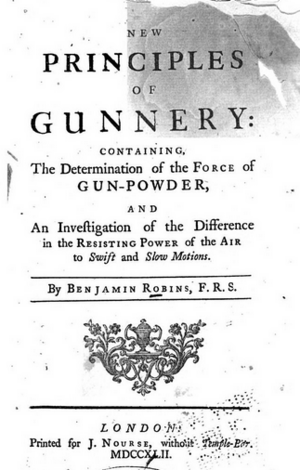Benjamin Robins facts for kids
Benjamin Robins (born 1707 – died 29 July 1751) was a brilliant British scientist. He was a mathematician who followed Isaac Newton's ideas. He was also a military engineer. Robins wrote an important book about how guns work. This book was the first to use Newton's science for military purposes. He was also very interested in rifled gun barrels. His work greatly helped improve artillery (big guns) in the late 1700s. It also led to teaching calculus in military schools.
Contents
Early Life and Learning
Benjamin Robins was born in Bath, England. His parents were Quakers and did not have much money. Because of this, he did not get much formal schooling. A smart doctor named Henry Pemberton (1694–1771) saw how talented Robins was. Dr. Pemberton advised him to go to London. For a while, Robins earned money by teaching mathematics. But soon, he focused on engineering and studying how to build strong forts.
Amazing Work with Guns
Robins did many important experiments with guns. He wrote down all his findings in a famous book called New Principles of Gunnery (1742). In this book, he described his ballistic pendulum. This was a special device used to measure how fast a cannonball or bullet traveled. It was like an early version of a chronograph.
Robins also did experiments to see how much air slowed down flying objects. He studied the power of gunpowder. He calculated how fast projectiles would move when fired. He compared his ideas with real-life tests of how far mortars and cannons could shoot. He also gave helpful tips on how to use artillery better. He even studied how rockets flew. He wrote about why rifled gun barrels were better. A famous scientist named Leonhard Euler translated Robins's book into German. Euler also added his own notes. Robins's work was very important for improving the accuracy of Prussian artillery. This helped Frederick the Great make his army's artillery among the best in Europe.
His Math Studies
Robins also wrote about mathematics. Some of his math writings are less well-known today. These include his Discourse concerning the Nature and Certainty of Sir Isaac Newton's Methods of Fluxions and of Prime and Ultimate Ratios (1735). He also wrote A Demonstration of the Eleventh Proposition of Sir Isaac Newton's Treatise of Quadratures (1727). These works showed his deep understanding of Newton's advanced math ideas.
Involvement in Politics
Besides his science, Robins was also active in politics. He wrote papers that supported the group against Sir Robert Walpole. Walpole was a very powerful politician at the time. Robins was also a secretary for a special group from the House of Commons. This group looked into Walpole's actions. Robins also wrote an introduction for a report about Lieutenant-General Sir John Cope. In this, he explained the events of the battle of Prestonpans.
In 1749, Robins was given an important job. He became the chief engineer for the East India Company. He traveled to India to help rebuild their forts. But his health quickly got worse. He died at Fort St David in India. All his works were put together and published in two books in 1761.
Sources
- O'Connor, John J; Edmund F. Robertson "Benjamin Robins". MacTutor History of Mathematics archive.


